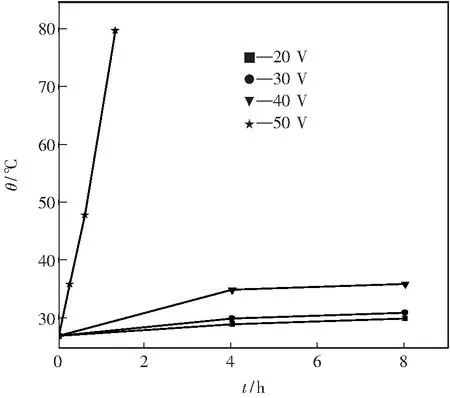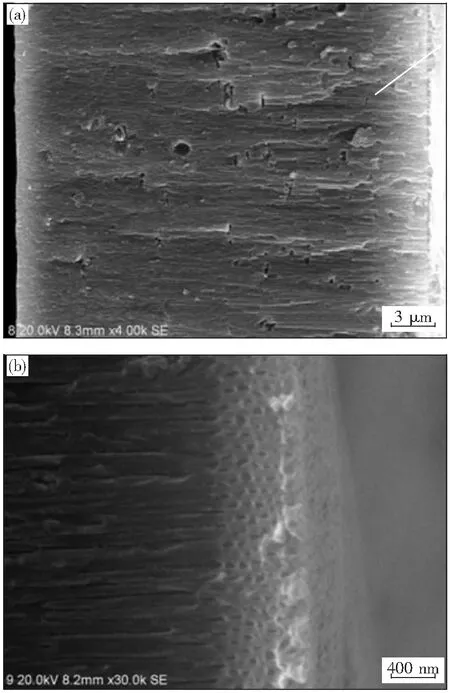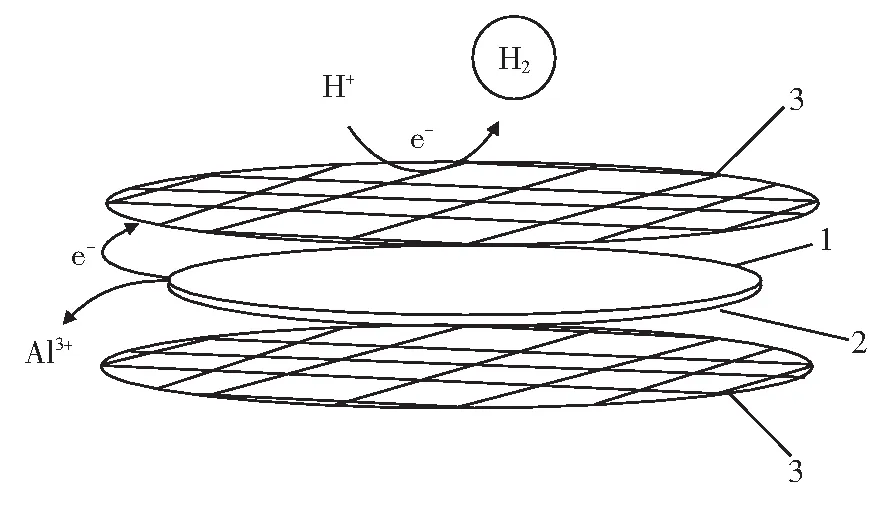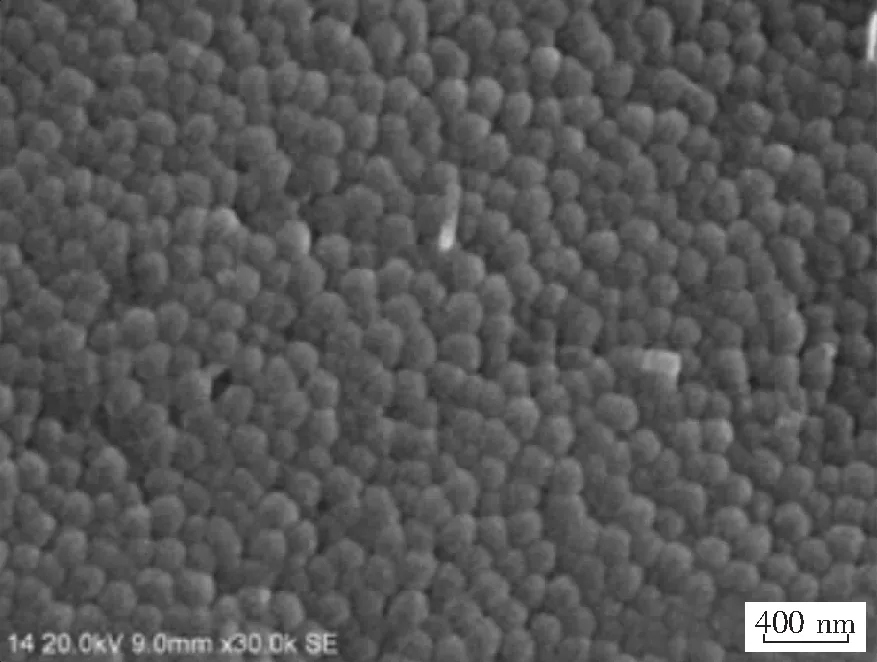转移反应热和去除铝基底实验研究
张晓艳,王明华,陈忠翼,翟玉春
(东北大学冶金学院,沈阳110819 )
转移反应热和去除铝基底实验研究
张晓艳,王明华,陈忠翼,翟玉春
(东北大学冶金学院,沈阳110819 )
铝在阳极氧化过程中放出来的热量对阳极氧化铝(AAO)模板的制备易产生不利影响,与铝基底紧连的阻挡层产生的焦耳热是主要热源.通过将铝基底置于草酸电解液外,考察了阳极氧化电压、冷却方式等因素对AAO模板制备的影响.结果表明,阳极氧化电压和冷却方式均影响电解液温度和AAO模板孔道直径尺寸.空气冷却时,30 V电压氧化8 h,制备的模板孔道直径约为40 nm,电解液温度为31 ℃;水浴冷却时,40 V电压氧化8 h,制备的模板孔道直径约为80 nm,电解液温度为25 ℃,且制备的AAO模板表面没有纳米氧化铝纤维.采用乙醇/浓盐酸混合溶液溶解铝基底,乙醇/浓盐酸的体积比为2~3时,溶解铝基底的时间约为 30 min,AAO模板不受损害.
AAO模板;阳极氧化;反应热;铝基底
阳极氧化铝(AAO)模板具有孔道规则、孔径可调等优点[1-2],在各种纳米线[3-4]、纳米管[5]等纳米材料的合成研究中被广泛采用.AAO模板的孔径尺寸易受电压、温度等因素影响,一般施加的电压越大、电解液温度越高制备的模板孔径尺寸越大[6-8].电压较高时,通常电流密度较大[6-7],放热较多[9-11],模板易被击穿、甚至燃烧[12-13].电流流过模板孔底部的阻挡层(铝基底与模板多孔层间的衔接部分,见图1)时产生的焦耳热被认为是热量的主要来源[9-11].
焦耳热的计算公式如下:
其中:Q为焦耳热;I为电流;R为阻挡层电阻;t为反应时间.
阳极氧化后如欲得到AAO模板,一般需要将铝基底去除.通常采用CuCl2[4,14-16]、HgCl2[17-19]或SnCl4[20-22]等溶液置换去除铝基底[1-2],但因其存在反应时间长、铝基底易残留[23]以及需要使用重金属离子等缺点,严重制约了AAO模板的工业化生产.本研究采用乙醇/浓盐酸混合溶液溶解铝基底,可避免重金属离子污染.
在常规的阳极氧化装置中铝基底通常被浸入在电解液中[9,24-25].考虑到阻挡层是主要的发热部位[9-11],且铝基底与发热源阻档层紧密接触,而铝基底具有良好的导热性能,直接对铝基底降温,有利于热量的转移.因此,本文将紧连阻挡层的铝基底置于电解液外,实验装置结构与文献[13]报道的相似,区别在于采用对流传热方式转移反应热,考察电压、冷却方式等条件对电解液温度和模板孔道直径尺寸的影响.阳极氧化后,将含铝基底的AAO模板置于两片铜网之间,运用电化学腐蚀原理在乙醇/浓盐酸混合溶液中溶解铝基底.
1 实验部分
将纯度为99.5%、规格为40 mm×40 mm×200 μm的铝片在400 ℃马弗炉中退火4 h,随炉冷却至室温后浸入到60 ℃、5%(质量比)的NaOH溶液中,持续时间30 s,以去除表面的氧化层,再用5%(质量比)的HNO3溶液中和60 s.在90 mA/cm2的电流密度下,用HClO4/C2H5OH体积比为1/4的混合溶液电化学抛光铝片180 s.将抛光后的铝片在150 mL浓度为0.3 mo1/L的草酸溶液中进行阳极氧化.阴极为相同材质的铝片.电解槽为有机玻璃材质,厚度约为5 mm.阳极氧化后,去除含铝基底AAO模板的边缘部分,置于两片铜网(网孔尺寸为0.9 mm×0.9 mm)之间,再浸入到约30 mL的乙醇/浓盐酸混合溶液中,使铜网与铝基底接触形成原电池结构.铝基底被完全溶解后得到单通AAO模板.
2 结果与讨论
2.1 空气冷却
图2为空气冷却条件下阳极氧化反应装置示意图.鉴于金属铝的导电、导热性能良好,采用与阳极铝片相同材质的金属铝板作为阳极支撑物.阳极氧化过程中,金属铝板的温度比电解液的温度稍高,这是由于金属铝的导热性能较好,阳极氧化过程中阻挡层处产生的热量[9-11]可以迅速地经过铝基底传递给金属铝板,而热量传递给电解液则需要经过狭窄的模板孔道,液体的对流传热受到限制[11],另外,电解液的导热性能较差,量又较多,因此,金属铝板的温度比电解液的温度稍高.

图2 空气冷却条件下阳极氧化装置示意图
空气冷却、不同阳极氧化电压下,电解液温度-时间变化曲线如图3所示.由图3可知,电压为50 V时,电解液的温度在短时间内迅速上升;而电压为20、30、40 V时,电解液的温度随着阳极氧化反应时间的延长缓慢升高.在相同的反应时间,施加的电压越高,电解液的温度升高得越快,这是由于空气的散热性能较差,阳极氧化过程中产生的热量不易通过金属铝板发散出去,使电解液温度升高,施加的电压越高,电流密度越大[6,7],反应越快,放热越明显[9-11],电解液的温度就升高得越快.

图3 空气冷却条件下,电解液温度-时间曲线
图4为空气冷却、不同阳极氧化电压下制备的AAO模板孔道SEM形貌.由图4可知,模板的孔道形状较为规则.20 V电压氧化8 h时,制备的模板孔道直径约为20 nm,电解液温度约为30 ℃;30 V电压氧化8 h时,制备的模板孔道直径约为40 nm,电解液温度约为31 ℃;40 V电压氧化8 h时,制备的模板孔道直径约为120 nm,电解液温度约为36 ℃.空气冷却条件下,阳极氧化时间相同时,施加的电压越大,电解液的温度越高,制备的模板孔道直径尺寸越大.50 V电压氧化时,电解液的温度在短时间内迅速升高了,制备的模板厚度非常薄,并且易碎.
2.2 水浴冷却
将图2的装置置于约25 ℃室温水浴中,使金属铝板与水浴充分接触.不同阳极氧化电压下制备的AAO模板孔道SEM形貌如图5所示.由图5可知,40 V电压氧化8 h时,制备的模板孔道直径约为80 nm,电解液温度仍约为25 ℃;50 V电压氧化8 h时,制备的模板孔道直径约为130 nm,电解液温度约为25 ℃.水浴冷却条件下,电压较高时制备的模板孔道直径尺寸较大,与文献[6-8]中观察到的现象基本一致.在40 V或50 V电压下阳极氧化,水浴冷却时电解液的温度几乎不变化,这是因为金属铝的导热性能良好,阻挡层处产生的热量[9-11]可以很快地通过铝基底和金属铝板传递给水,水的散热性能较好,因此,电解液的温度几乎不变化.

图4 空气冷却条件下制备的AAO模板孔道SEM形貌

图5 水浴冷却条件下制备的AAO模板孔道SEM形貌
40 V电压下,空气冷却时制备的模板表面存在有纳米氧化铝纤维(图6a右侧);而水浴冷却时制备的模板表面没有纳米氧化铝纤维形成(图6b),并且空气冷却条件下制备的模板孔道直径为120 nm(图4c)略大于水浴冷却条件下制备的模板孔道直径80 nm(图5a).这是由于空气冷却条件下,空气的散热性能较差,阳极氧化产生的热量不易通过金属铝板和周围的空气传递出去,对模板孔道内的电解液产生加热作用,电解液的温度较高(图3),模板孔壁溶解较快[26],因此,空气冷却条件下制备的模板表面存在有纳米氧化铝纤维,并且孔道直径较大;而水浴冷却条件下,水的散热性能较好,阳极氧化反应产生的热量可以很快地通过金属铝板及周围的水传递出去,电解液温度较低,模板孔壁溶解较慢[26],因此,水浴冷却条件下制备的模板表面没有纳米氧化铝纤维,并且孔道直径较小.

图6 40 V电压下制备的模板横断面SEM形貌
2.3 铝基底去除
将含铝基底的AAO模板置于两片铜网之间(见图7),浸入到乙醇/浓盐酸混合溶液中,使铜网与铝基底接触形成原电池结构.铝基底作原电池的阳极,铜网作阴极.作为阳极的铝基底首先失去电子生成Al3+进入到溶液中,失去的电子转移给铜网,然后溶液中的H+在铜网上得到电子生成H2排出.上述过程持续进行,直到铝基底被完全溶解.排出的H2使含铝基底的AAO模板在翻腾的液体中不停地晃动,为防止铝基底与铜网分离,将含铝基底的模板夹在两片铜网之间.溶解铝基底的过程中,铜网的性质和质量几乎不发生变化,起到加速铝基底溶解的作用.铜网可循环使用.

图7 铝基底溶解机理图
乙醇/浓盐酸的体积比为2~3时,溶解铝基底的时间约为30 min.铝基底被完全溶解后,模板的表面(图6)及阻挡层(图8)均保持完好,AAO模板几乎不受损害.乙醇/浓盐酸的体积比≥4时,溶解铝基底的时间明显延长.乙醇/浓盐酸的体积比≤1时,反应剧烈并大量放热.

图8 50 V电压水浴冷却条件下制备的模板阻挡层SEM形貌
3 结 论
(1) 铝基底置于电解液外,空气冷却时,阳极氧化电压越大,电解液温度升高得越快,制备的模板孔道直径尺寸越大;水浴冷却时,阳极氧化电压越高,制备的模板孔道直径也越大,但小于同电压空气冷却时制备的模板孔道直径,电解液的温度几乎不变化.将铝基底置于电解液外通过水浴冷却转移反应热是可行的.
(2) 溶解铝基底后的溶液中,除铜网和AAO模板为固体外,其余为液体,容易实现固液分离.溶液中的金属离子几乎全部为铝离子,便于回收利用,无重金属离子,绿色环保,对环境污染小.乙醇/浓盐酸的体积比为2~3时,溶解铝基底的时间约为 30 min.
[1]Zhang L D, Fang X S, Ye C H. Controlled growth of nanomaterials [M]. Singapore: World Scientific, 2007: 167-175.
[2]Lupu N. Electrodeposited nanowires and their applications [M]. Croatia: InTech, 2010: 86, 113-119.
[3]Peng Y T, Chen Q F. Fabrication and characterization of crystalline copper nanowires by electrochemical deposition inside anodic alumina template [J]. Chinese science bulletin, 2013, 58(27): 3409-3414.
[4]Jia Y Y, Yang D C, Luo B,etal. One-pot synthesis of Bi-Ni nanowire and nanocable arrays by coelectrodeposition approach [J]. Nanoscale Research Letters, 2012, 7(1): 1-6.
[5]Chowdhury T, Casey D P, Rohan J F. Additive influence on Cu nanotube electrodeposition in anodised aluminium oxide templates [J]. Electrochemistry Communications, 2009, 11(6): 1203-1206.
[6]Stępniowski W J, Bojar Z. Synthesis of anodic aluminum oxide (AAO) at relatively high temperatures. Study of the in-uence of anodization conditions on the alumina structural features [J]. Surface and Coatings Technology, 2011, 206(2-3): 265-272.
[7]Stępniowski W J, Michalska-Domańska M, Norek M,etal. Anodization of cold deformed technical purity aluminum (AA1050) in oxalic acid [J]. Surface and Coatings Technology, 2014, 258: 268-274.
[8]Stępniowski W J, Norek M, Michalska-Domańska M,etal. Ultra-small nanopores obtained by self-organized anodization of aluminum in oxalic acid at low voltages [J]. Materials Letters, 2013, 111: 20-23.
[9]Chowdhury P, Thomas A N, Sharma M,etal. An approach for in situ measurement of anode temperature during the growth of self-ordered nanoporous anodic alumina thin films: influence of joule heating on pore microstructure [J]. Electrochimica Acta, 2014, 115: 657-664.
[10]Chung C K, Chang W T, Liao M W,etal. Fabrication of enhanced anodic aluminum oxide performance at room temperatures using hybrid pulse anodization with effective cooling [J]. Electrochimica Acta, 2011, 56(18): 6489-6497.
[11]Wang Y, Santos A, Evdokiou A,etal. Rational design of ultra-short anodic alumina nanotubes by short-time pulse anodization [J]. Electrochimica Acta, 2015, 154: 379-386.
[12]Zhang R, Jiang K M, Zhu Y,etal. Ultrasound-assisted anodization of aluminum in oxalic acid [J]. Applied Surface Science, 2011, 258(1): 586-589.
[13]Lee W, Ji R, Gösele U,etal. Fast fabrication of long-range ordered porous alumina membranes by hard anodization [J]. Nature materials, 2006, 5(9): 741-747.
[14]Li Y, Ling Z Y, Wang J C,etal. Fabrication of porous alumina templates with a large-scale tunable interpore distance in a H2C2O4-C2H5OH-H2O solution[J]. Chinese Science Bulletin, 2008, 53(10): 1608-1612.
[15]Proenca M P, Sousa C T, Ventura J,etal. Ni growth inside ordered arrays of alumina nanopores: Enhancing the deposition rate [J]. Electrochimica Acta, 2012, 72: 215-221.
[16]Shang G L, Fei G T, Xu S H,etal. Preparation of the very uniform pore diameter of anodic alumina oxidation by voltage compensation mode [J]. Materials Letters, 2013, 110: 156-159.
[17]Chen Y H, Shen Y M, Wang S C,etal. Fabrication of one-dimensional ZnO nanotube and nanowire arrays with an anodic alumina oxide template via electrochemical deposition [J]. Thin Solid Films, 2014, 570: 303-309.
[18]Lee J, Kim D H, Hong S H,etal. A hydrogen gas sensor employing vertically aligned TiO2nanotube arrays prepared by template-assisted method [J]. Sensors and Actuators B: Chemical, 2011, 160(1): 1494-1498.
[20]TAkiya S, Kikuchi T, Natsui S,etal. Self-ordered porous alumina fabricated via phosphonic acid anodizing [J]. Electrochimica Acta, 2016, 190: 471-479.
[21]TKikuchi T, Yamamoto T, Suzuki R O. Growth behavior of anodic porous alumina formed in malic acid solution [J]. Applied Surface Science, 2013, 284: 907-913.
[22]TLi D D, Jiang C H, Jiang J H,etal. Investigation on highly ordered porous anodic alumina membranes formed by high electric field anodization [J]. Materials Chemistry and Physics, 2008, 111(1): 168-171.
[23]张立德, 解思深. 纳米材料和纳米结构[M]. 北京:化学工业出版社, 2005: 172-181. (Zhang Lide, Xie Sishen. Nanomaterials and nanostructures [M]. Beijing: Chemical Industry Press, 2005: 172-181.)
[24]TJani A M M, Losic D, Voelcker N H. Nanoporous anodic aluminium oxide: Advances in surface engineering and emerging applications [J]. Progress in Materials Science, 2013, 58(5): 636-704.
[25]TKikuchi T, Nishinaga O, Natsui S,etal. Self-ordering behavior of anodic porous alumina via selenic acid anodizing [J]. Electrochimica Acta, 2014, 137: 728-735.
[26]TManzano C V, Martín J, Martín-González M S. Ultra-narrow 12 nm pore diameter self-ordered anodic alumina Templates [J]. Microporous and Mesoporous Materials, 2014, 184: 177-183.
Experimental study on transfer of reaction heat and removal of aluminum substrate
Zhang Xiaoyan,Wang Minghua,Chen Zhongyi,Zhai Yuchun
(School of Metallurgy,Northeastern University,Shenyang 110819, China)
Heat generated during the anodic oxidation of aluminum plate has a negative effect on preparation of anodic aluminum oxide (AAO) template. Joule heat is the main heat source, and it is generated from the barrier layer of aluminum substrate. Placed the aluminum substrate outside the oxalic acid electrolyte, effects of anodic voltage, cooling mode and other factors on preparation of AAO template were investigated. The results indicated that both channel diameter of AAO template and electrolyte temperature are affected by anodic voltage and cooling mode. Under a condition of the air cooling, anodic voltage of 30 V and anodization time of 8 h, the channel diameter of prepared template is about 40 nm, and the electrolyte temperature is about 31 ℃. When it was cooled by water, anodic voltage was 40 V and anodization time was 8 h, the channel diameter of prepared template is about 80 nm, the electrolyte temperature is about 25 ℃, and there are no alumina nano-fibers on the surface of prepared AAO template. When a mixed solution of ethanol and concentrated hydrochloric acid with the volume ratio of 2~3 was used to dissolve the aluminum substrate, the dissolution time of aluminum substrate is about 30 min, and the AAO template is not damaged.
AAO template; anodization; reaction heat; aluminum substrate
10.14186/j.cnki.1671-6620.2016.03.010
O 646
A
1671-6620(2016)03-0209-05

